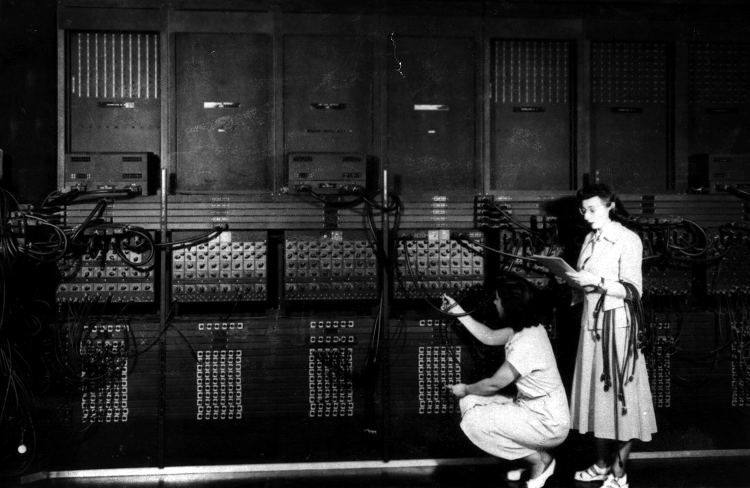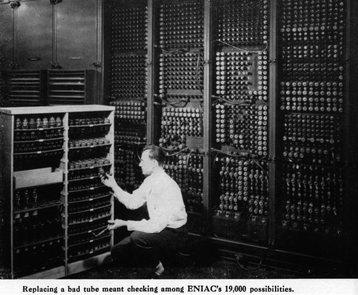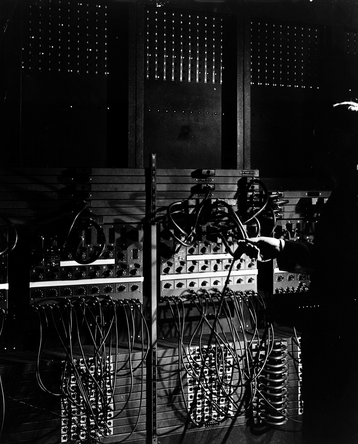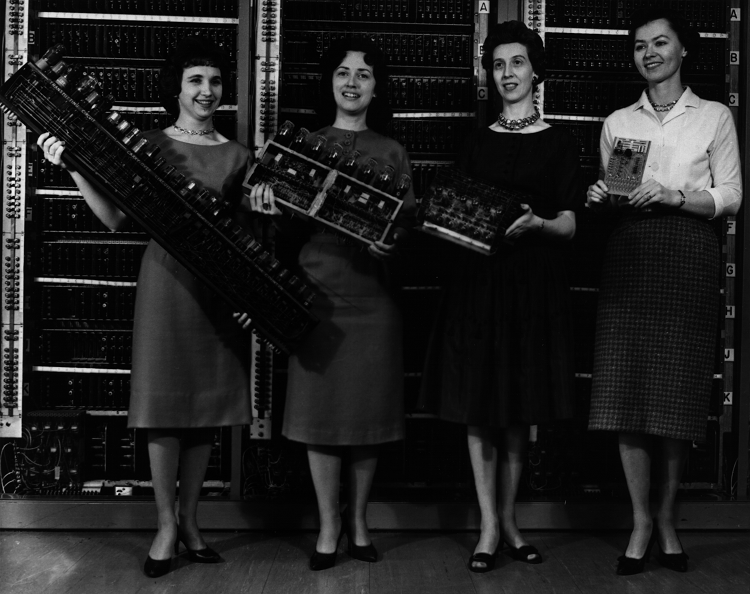2021 marks 75 years since Electronic Numerical Integrator and Computer (ENIAC) was first revealed to the public. An important part of computing history, ENIAC’s development was a collection of important milestones.
ENIAC may have been the first electronic general-purpose machine that was Turing complete - i.e. theoretically able to handle any computational problem. Its development was key to the founding of the commercial computing industry, providing many of the early ideas and principles that underpin computers of all shapes and sizes.
A ‘revolution in the mathematics of engineering’
Built between 1943-1945 at the University of Pennsylvania by engineers John Presper Eckert and John William Mauchly, ENIAC was created to calculate artillery tables - the projectile trajectories of explosive shells - for the US Army Ballistics Research Laboratory.
Mauchly proposed using a general-purpose electronic computer to calculate ballistic trajectories in 1942 in a five-page memo called The Use of Vacuum Tube Devices in Calculating. After getting wind of the idea, the US Army commissioned the university to build the machine, known as the time as Project PX. The system was completed and brought online towards the end of 1945, and moved to the Aberdeen Proving Ground in Maryland in 1947.
Taking up a 1,500-square-foot room at UPenn’s Moore School of Electrical Engineering, ENIAC comprised 40 nine-foot cabinets. Weighing 30 tons, the machine contained over 18,000 vacuum tubes and 1,500 relays, as well as hundreds of thousands of resistors, capacitors, and inductors.
“It was a bunch of guys bending metal in the basement of a building in UPenn,” says Jim Thompson, CTO of the ClearPath Forward product at Unisys, a company that through acquisitions can trace its lineage back to ENIAC, and the Eckert-Mauchly Corporation, founded in 1946. “There was nobody building computer parts; these guys made ENIAC literally out of radios and televisions and everything else they could find, taking vacuum tubes that were designed for a different purpose and then turning them into logic devices and repurposing them.”
After the end of WW2, ENIAC was donated to the University of Pennsylvania on February 15, 1946. According to the Smithsonian, where parts of the machine now reside, an Army press release at the time described ENIAC as “a new machine that is expected to revolutionize the mathematics of engineering and change many of our industrial design methods.
“Begun in 1943 at the request of the Ordnance Department to break a mathematical bottleneck in ballistic research, its peacetime uses extend to all branches of scientific and engineering work.”
Prior to ENIAC, human ‘computers,’ mostly teams of women, performed calculations by hand with mechanical calculators. Predicting a shell’s path used calculations that took into account air density, temperature, and wind. A single trajectory took a person around 20 to 40 hours to ‘compute.’ With ENIAC, the same calculations were now possible in 30 seconds.
Input was done through an IBM card reader and an IBM card punch was used for output. While ENIAC had no system to store memory at first, the punch cards could be used for external memory storage. A 100-word magnetic-core memory built by the Burroughs Corporation was added to ENIAC in 1953.
Capable of around 5,000 calculations a second, ENIAC was a thousand times faster than any other machine of the time and had modules to multiply, divide, and square root.
“This was a machine that straddled the point in history where we went from mechanical calculators and adding machines to electronic computers,” says Thompson.
While a massive step-change in terms of capability compared to any other computer in the world at the time, it also had various challenges in operation. With minimal cooling technology – two 20-horsepower blowers – ENIAC raised the room temperature to 50ºC when in operation and its 160kW energy consumption caused blackouts in the city of Philadelphia.
Reliability was also a constant challenge. Before speciality tubes became available in 1948, the machine used standard radio tubes, which burnt out on a near-daily basis. At first it took hours to work out which tube had actually blown, but the team eventually developed a system to reduce this down to around 15 minutes thanks to some ‘predictive maintenance’ and careful monitoring of equipment.
ENIAC was difficult and complicated to use. Initially, it used patch cables and switches for its programming, and reprogramming the machine was a physically taxing task requiring a lot of preplanning and often took days to do.
“The first electronic digital computers, including ENIAC, had to be programmed by wiring using patch cords,” explains David Taylor, co-founder of coding tutorial site Prooffreader and a computing history enthusiast.
“Once a program was written, the program-specific logic had to be literally wired into the machine, meaning programmers had to physically move the cables on a plugboard and change the switches that controlled the response to inputs.
“ENIAC was then able to solve only that particular problem. To change the program, the machine’s data paths had to be hand-wired again. This was a quite laborious process, taking a few days to make the necessary physical changes and weeks to design and write new programs.”
Improvements in 1948 made it possible to execute stored programs set in function table memory, speeding up the ‘programming’ process.
“The three different kinds of memory used in ENIAC were replaced with a single, erasable high-speed memory, allowing programs to be stored in the form of read-only memory,” says Taylor. “This conversion immensely sped up the reprogramming process, taking only a few hours instead of days.”
ENIAC’s legacy: an important part of history
The late 1930s to 1940s were rife with computing pioneers developing historically significant machines, all to help the war effort.
IBM’s Harvard Mark I - another general purpose machine of the era - was capable of just three additions or subtractions per second, while multiplications each took six seconds, divisions 15 seconds, and a logarithm or a trigonometric function more than a minute.
The UK’s Colossus, built at Bletchley Park, was incredibly important to deciphering Nazi cryptography, but was built for one specific purpose and government secrecy meant its learnings couldn’t be shared at the time.
The Atanasoff–Berry computer, built in 1942 by John V. Atanasoff, was neither programmable nor Turing-complete.
The Konrad Zuse-built Z3 was completed in Berlin in 1941 but government funding was denied as it was not viewed as important. The machine never put into everyday use, and was destroyed during Allied bombing of Berlin in 1943.
“It’s easy to focus on how slow, massive, power-hungry and memory-poor these early computers were, rather than recognizing the exponential leaps in technology that they represented compared to the previous state of the art,” says Charlie Ashton, senior director of business development at SmartNIC provider Napatech.
“One of the most impressive statistics about ENIAC is the multiple-orders-of-magnitude improvement in performance compared to the electro-mechanical machines that it replaced.
While historians may argue over the importance of certain machines and which ones have the honor of being ‘first’ in various categories, few can argue over whether ENIAC was a leap forward and had a real-world impact. Its computing power was a massive leap in comparison to its peers at the time, and its general purpose nature led the way for computers being re-programmable for any number of potential use cases.
“There were other computers (mechanical and electro-mechanical) before it. And we can over-index on the fact that it was the first working general purpose digital computer, but the impact was far greater,” says Charles Edge, CTO of startup investment firm Bootstrappers.mn and host of The History Of Computing Podcast.
At a cost of around $400,000 at the time - equivalent to around $7 million today - ENIAC was a relative bargain, even if the original project budget was just $61,700. The machine was retired in October 1955 after a lightning strike, but it had already made a lasting mark on the nascent computer industry.
ENIAC a failure and a success
By the time ENIAC was ready for service in 1945, the war was coming to an end. And as a result, it was never actually used for its intended purpose of calculating ballistic trajectories.
“The difference for ENIAC was it really was a general-purpose problem solver,” says Thompson. “Even though it showed up late in the war and didn't really contribute to its original design purpose, it was immediately adapted to help with the US effort around nuclear weapons, to do agriculture work, and anything where we had to do a lot of computations quickly.”
During its lifetime, the machine performed calculations for the design of a hydrogen bomb, weather predictions, cosmic-ray studies, random-number studies, and even wind-tunnel design. ENIAC’s work to investigate the distance that neutrons would likely travel through various materials helped popularize Monte Carlo methods of calculations.
“ENIAC certainly goes down as a pivotal moment in computing,” says Edge. “It was important in the mathematical modeling that led to the hydrogen bomb. In part out of that work, we got the Monte-Carlo simulation and von Neumann’s legacy coming from that early work. We got the concept of stored programs.”
Mauchly’s interest in computers reportedly stemmed from hopes of forecasting the weather through computers and using electronics to aid statistical analysis of weather phenomena. And ENIAC did in fact conduct the first 24-hour weather forecast. But, as with most computers of the time, John von Neumann and the specter of nuclear weapons research was an important part of ENIAC’s output.
While working on the hydrogen bomb at Los Alamos National Laboratory, von Neumann grew aware of ENIAC’s development, and after becoming involved in its development, the machine’s first program was not ballistics tables but a study of the feasibility of a thermonuclear weapon. von Neumann also worked with IBM’s Harvard Mark I, and essentially created the von Neumann architecture when documenting his thoughts on the ENIAC’s successor machine, the EDVAC.
Many ENIAC researchers gave the first computer education talks in Philadelphia, Pennsylvania in 1946 that are collectively known as The Theory and Techniques for Design of Digital Computers and often referred to as the Moore School Lectures.
The talks were highly influential in the future development of computers. “The Moore School Lectures helped produce Claude Shannon of Bell Labs, Jay Forrester at MIT, mainframe developers from GE which would go on to be a substantial player in the mainframe industry, and engineers, researchers, and the future of the still-nascent computer industry,” says Edge.
The Pentagon invited experts from Britain as well as the US to jumpstart research in the field. The Lectures, and von Neumann’s memo, First Draft of a Report on the EDVAC, sparked off a race to create truly general-purpose systems which could run from stored programs.
Mauchly and Eckert were quick to build on their ideas, delivering EDVAC (Electronic Discrete Variable Automatic Computer) to the US Army’s Ballistic Research Laboratory in 1949. Design work began before ENIAC was even fully operational, implementing architectural and logical improvements conceived during the ENIAC's construction.
However, they were beaten by the Manchester Baby system, the first stored-program computer, and narrowly by the EDSAC in Cambridge, which is regarded as the first practical computer, and the origin of business computing via the Lyons Leo.
“ENIAC also heralded a variety of build techniques that persist to this day,” says Thompson. “It was a modular design, it was a scalable site so you can add more capability to it, you can change capability.”
“Over its lifetime, which was just shy of a decade, they added all kinds of technology to it that changed from how it was at the beginning to how it was at the end. That becomes sort of a blueprint for computing as you and I know it.”
The start of commercial computing
Today, technology names are some of the most valuable brands in the world. But even in the 1940s, technology was able to captivate the media.
With Bletchley Park’s Colossus still a state secret, ENIAC was free to grab the headlines.
A NY Times headline from February 1946 read ‘Electronic Computer Flashes Answers, May Speed Engineering.’ In other publications, ENIAC was described by the press at the time as the “mechanical brain” and “electronic Einstein.”
ENIAC had an early technology marketing campaign. Javier García, academic director of the engineering and sciences area at the U-tad University Center, Spain, explains that as funding dried up after the end of the war, the creators of ENIAC produced and exhibited a film about its operation to drive interest. In one marketing trick, the team incorporated panels with light and ping-pong balls with painted numbers that lit up while carrying out an operation to impress viewers.
“They were useless. Mere aesthetics. But in the popular imagination, it has remained as the image of the first computers. Just look at science fiction films. In fact, to reach more people, these bulbs are defined as an electronic brain. An absolute marketing success,” Garcia told El Pais.
While neither ENIAC nor EDVAC, nor the British EDSAC, were sold on the market, Mauchly and Eckert’s work was an important leap forward for the commercialization of computing.
The two launched the first computer company, Electronic Control Co., in 1946 after leaving UPenn over patent disputes. Unable to find a bank or investor that would lend them money, the two borrowed $25,000 from Eckert's father to get the business off the ground.
Due to financial issues, the renamed Eckert-Mauchly Computer Co. was sold in 1950 to Remington-Rand.
Eckert-Mauchly developed two successor machines: BINAC was the US’s first stored program computer in 1949, while UNIVAC didn’t launch till 1951, after acquisition by Remington-Rand. With varying degrees of success, these helped kickstart the sale and use of computers for dedicated business purposes in the US.
“At that point in time IBM was in the business,” says Thompson. “IBM did a better job of making that pivot and commercializing, but Eckert and Mauchly were there at the beginning and they started producing standardized computers that could be built in volume for the day – that is more than one – from a standard set of designs and sold to customers to do a general set of tasks. So that's a pretty big switch from a machine that's built for a purpose.
“Within 10 years of its birth and five after having been shut down, we were building general-purpose commercial computers. It created a whole new industry. We would not have programmers, we would not have system designers, we wouldn't have all kinds of things that we have [today]. Not 15 years out from ENIAC we're building computers to go to the Moon.”
Northrop accepted the first BINAC in September 1949, but it reportedly never worked properly after it was delivered and was never used as a production machine. Northrop blamed EMCC for packing the machine incorrectly, while Eckert and Mauchly said Northrop had assembled it poorly and wouldn't let its engineers on-site to fix it.
However, after the Rand acquisition, the first UNIVAC was successfully delivered to the United States Census Bureau in March 1951. The fifth machine – built for the US Atomic Energy Commission – was famously used by CBS to correctly predict the result of the 1952 presidential election in a marketing scheme cooked up by the pair.
Though not in name, Eckert and Mauchly’s company lives on today. Rand merged with Sperry Corp. in 1955 and then Burroughs in 1986 and became Unisys. Eckert retired from Unisys in 1989.





